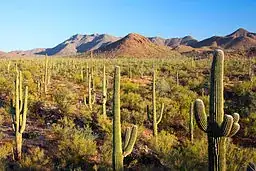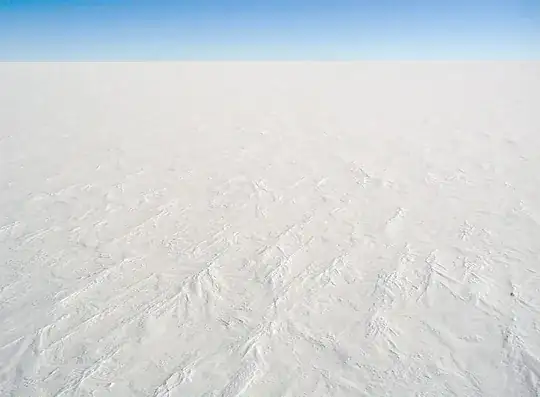These rankings are all a matter of what counts and what doesn’t. For examples, I’ve constructed three similar rankings, each one a little stricter—which forces out some contenders, and gives those below them that are still left higher rankings. This way we can see how Rub' al Khali can be largest in one ranking, while larger-still deserts are found in the more permissive rankings:
Any desert
The largest deserts (and select desert subsets) on Earth are...
Antarctica—5,500,000 sq mi or 14,000,000 km2
Arctic—5,400,000 sq mi or 13,985,000 km2
Sahara—3,300,000 sq mi or 9,000,000 km2
Arabian—900,000 sq mi or 2,330,000 km2
Gobi—500,000 sq mi or 1,000,000 km2
Kalahari—360,000 sq mi or 900,000 km2
Rub' al Khali—250,000 sq mi or 650,000 km2
Great Victoria—220,000 sq mi or 647,000 km2
Great Sandy–Gibson—210,000 sq mi or 556,000 km2
- Authorities vary on whether this is one desert or two; see below
[...]
Great Sandy—150,000 sq mi or 400,000 km2
- As a separate desert from the Gibson
[...]
Erg Chech—123,000 sq mi or 320,000 km2
[...]
Gibson—60,000 sq mi or 156,000 km2
- As a separate desert from the Great Sandy
Hot desert
The largest hot deserts (and select desert subsets) on Earth are...
Sahara
- Antarctica and the Arctic are left off because they are very cold
Arabian
Kalahari
- Gobi is kind of a mixed case, getting cold in the winter and hot in the summer; leaving it off here since this is defined as “hot” deserts
Rub' al Khali
- Still a subset of the Arabian
Great Victoria
Great Sandy–Gibson
- Still arguably two deserts
[...]
Great Sandy
[...]
Erg Chech
[...]
Gibson
Hot, sandy desert
The largest continuous areas of hot, sandy desert on Earth are...
Rub' al Khali
Per the Wikipedia article, the rest of the Arabian consists of
A corridor of sandy terrain known as the Ad-Dahna desert connects the large An-Nafud desert (65,000 km2 or 40,389 square miles) in the north of Saudi Arabia to the Rub' Al-Khali in the south-east.[citation needed]
The Tuwaiq escarpment is a region of 800 km (500 mi) arc of limestone cliffs, plateaux, and canyons.[citation needed]
Brackish salt flats: the quicksands of Umm al Samim[citation needed]
The Wahiba sands of Oman: an isolated sand sea bordering the east coast[citation needed]
Since there are non-sand areas within the Arabian, it cannot count as a whole in this list. Rub' al Khali is the largest sandy section, and thus tops this list.
“The Sahara is mainly rocky hamada (stone plateaus), Ergs (sand seas - large areas covered with sand dunes) form only a minor part,” quoth Wikipedia.
“The Kalahari Desert is a large semi-arid sandy savanna,” “A semi-desert, with huge tracts of excellent grazing after good rains,” and so on, all per Wikipedia again. Low rainfall, but not so low; you don’t get the “sand sea” effect here due to the presence of some plant life.
Great Sandy–Gibson
Again, if we treat them as one desert.
The Great Victoria Desert “consists of many small sandhills, grassland plains, areas with a closely packed surface of pebbles (called desert pavement or gibber plains) and salt lakes,” from yet more Wikipedia, so that’s why that’s gone.
Great Sandy
Without Gibson
Dropped from the list here are the Syrian (“The land is open, gravely desert pavement, cut with occasional wadis.”) and the Chihuahuan (“Several larger mountain ranges [...] create ‘sky islands’ of cooler, wetter, climates adjacent to, or within the desert, and such elevated areas have both coniferous and broadleaf woodlands, including forests along drainages and favored exposures,” “According to the World Wide Fund for Nature the Chihuahuan Desert may be the most biologically diverse desert in the world,” “it receives more precipitation than other warm desert ecoregions.”)
Erg Chech
After having dropped the Sonoran Desert, because, well, this:

which is the image on the top-right of the Wikipedia page.
[...]
Gibson
- The Gibson Desert is still behind the Thar Desert, as “Most of the desert is covered by huge shifting sand dunes that receive sediments from the alluvial plains and the coast.”
All numbers come from Wikipedia’s list of largest deserts, Wikipedia’s article on Rub' al Khali, and DavePhD’s answer, for Erg Chech, though I have created my own lists to emphasize various points.
Note that these rankings are fairly arbitrary: I just used Wikipedia’s list, added in Rub' al Khali, Great Sandy–Gibson as a single desert, and Erg Chech, to address the desert subsets that have been discussed in answers here, and applied my own (fairly arbitrary) filtering to the first list to produce the second and third. There is nothing special about my rankings; you could easily come up with different rules for what does or doesn’t count, and achieve different rankings. The point is that you have to pay very close attention to exactly what competition someone is coming in 1st in—qualifiers on it may make the achievement less than it first appears.
Also note that the numbers don’t always agree: DavePhD’s answer has a larger area for the Great Sandy–Gibson than Wikipedia does (possibly by including areas between the two deserts that would not be considered part of either when separated), as well as a smaller area for Rub' al Khali. Natural borders are not always fixed, and are not always clear, hard lines—differences of opinion in where the limit is, what does or doesn’t count as still being part of the same desert, etc. all can come into play, to say nothing of the possibility that they can and do shift over time.

